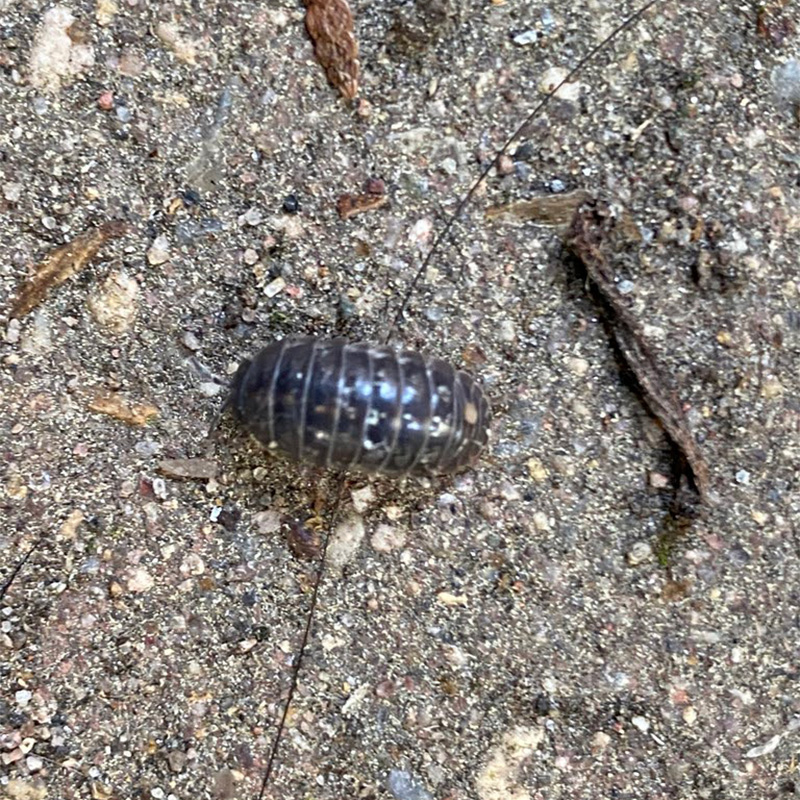Pill bugs aren’t bugs, but they are roly-poly, charmingly weird, harmless and even helpful

Pill bugs become active in spring. They overwinter as adults in a sheltered place. (Photo: Oonagh Degenhardt/iNaturalist)
Potato bug, roly-poly, doodlebug, sowbug, wood shrimp, pill bug, woodlice – we call these little guys, which resemble pea-sized armadillos, by many names depending upon what part of the country we live in. Most are misnomers, as the bugs are not insects at all, but rather tiny crustaceans with hard exoskeletons. That’s right, pill bugs (Armadillidium vulgare) are more closely related to lobsters and crabs than to ants and beetles. They are the only crustaceans adapted to living their entire life on land.
These little guys do not bite, sting, or transmit diseases. They do not infest your food, your clothing, or your wood. Perhaps that is why people feel no shyness about poking them to watch them roll up into a ball.

Pill bugs draw their antennae inside to roll up into a ball, called conglobation, when triggered by vibrations, pressure or when the temperature reaches 104 degrees Fahrenheit – helping prevent water loss. (Photo: Jef C. Taylor)
Pill bugs are tiny – about half an inch long – and dark gray, with seven pairs of legs and two pairs of antennae. They feed mainly on decaying plants and animals, rather than on your tender new garden shoots. They are decomposers who break down organic material, returning nutrients to the soil and improving it in the process.
Pill bugs need lots of moisture to survive (although they cannot survive under water), so during the day they rest under rocks, leaves, mulch, logs and flowerpots and perhaps occasionally in your damp basement. They come out primarily at night or when the temperature drops and the relative humidity of the air increases; in other words, they emerge when they are least likely to dry out.

Pill bugs have photoreceptors – eyes – on each side of the head, but they can detect only the presence or absence of light. (Photo: Oonagh Degenhardt; iNaturalist: Aniedes)
Like all crustaceans, pill bugs breathe through gills, which absorb oxygen from water and transport it into blood vessels that carry the oxygen to the rest of the body. These gills must remain moist. If a pill bug dries out, its gills do not work properly, and it can suffocate from lack of oxygen.
Pill bugs eat their own fecal matter. Scientists think this behavior, called coprophagy, evolved to help pill bugs retain hard-to-find copper – because pill bugs do not have iron-based hemoglobin in their blood like we do; instead their blood contains hemocyanin, which relies on copper to transport oxygen. When oxygenated, pill bug blood is pale blue.

A pill bug’s exoskeleton contains seven plates, which give it an armadillo-like appearance. (Photo: Joe MacIndawar/EarthwiseAware.org)
Humans and most other animals urinate to remove wastes from their bodies, but pill bugs release ammonia and other wastes as gases through small pores in their exoskeletons. Pill bugs have another unusual characteristic. They can absorb water at both ends – by drinking water through their mouths or wicking up water through two small tubes, called uropods, when they press their anus against wet surfaces.
Pill bug mating is brief: it lasts only a few seconds. The male climbs onto the female’s back and uses its first pair of limbs to transfer sperm to the female’s underside genital pores. The female can store the sperm for an entire year to use in several broods.

Pill bugs do not have ears and cannot hear. They sense vibrations through their antennae. (Photo: Josiah Couch/iNaturalist)
The female pill bug may carry two dozen fertilized eggs in a pouch underneath her body. The eggs hatch after three to four weeks. When hatched, the youngsters may stay in the mother’s pouch for another week or two. Then they leave and live independently for two to three years. A female pill bug can have up to three broods per year.
As they grow, young pill bugs molt their old exoskeleton every week or two for 18 weeks. This molting is a little unusual as it occurs in two stages: First, the pill bug sheds the front half of its exoskeleton. A few days later, it sheds the back half. This process helps prevent the pill bug from drying out. Adult pill bugs molt about every 29 days. For two days after a molt, while the exoskeleton hardens, the pill bug cannot move or eat; during this time the pill bug is vulnerable to predation or drying out.

To find others, a pill bug uses its antennae to sense pheromones emitted by other pill bugs. (Photo: Jef C. Taylor)
Pill bugs are native to southern Europe and northern Africa. They arrived on this continent with Europeans, either by hitching a ride in the soil of imported plants or in the earthen ballast of ships that got discarded ashore when holds were filled with other goods. Whatever the method of introduction, pill bugs today are found throughout North America and the world.
If on a rainy day you see a pill bug, do not harm this beneficial little crustacean. Turn it upside down briefly, perhaps, to take a look at its gills. Then release it to go on its unassuming way.

Studies have shown that pill bugs can survive three months without food. (Photo: Quinton Zondervan)
![]()
Have you taken photos of our urban wild things? Send your images to Cambridge Day, and we may use them as part of a future feature. Include the photographer’s name and the general location where the photo was taken.
Jeanine Farley is an educational writer who has lived in the Boston area for more than 30 years. She enjoys taking photos of our urban wild things.


